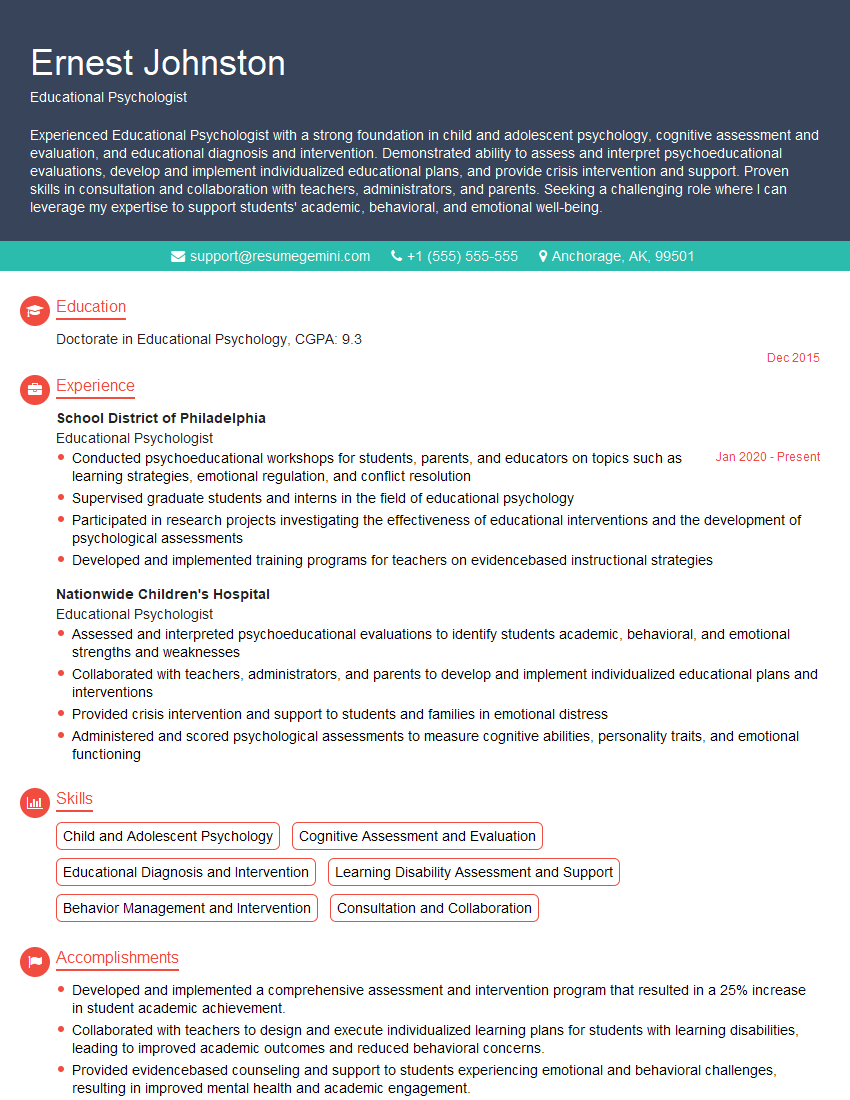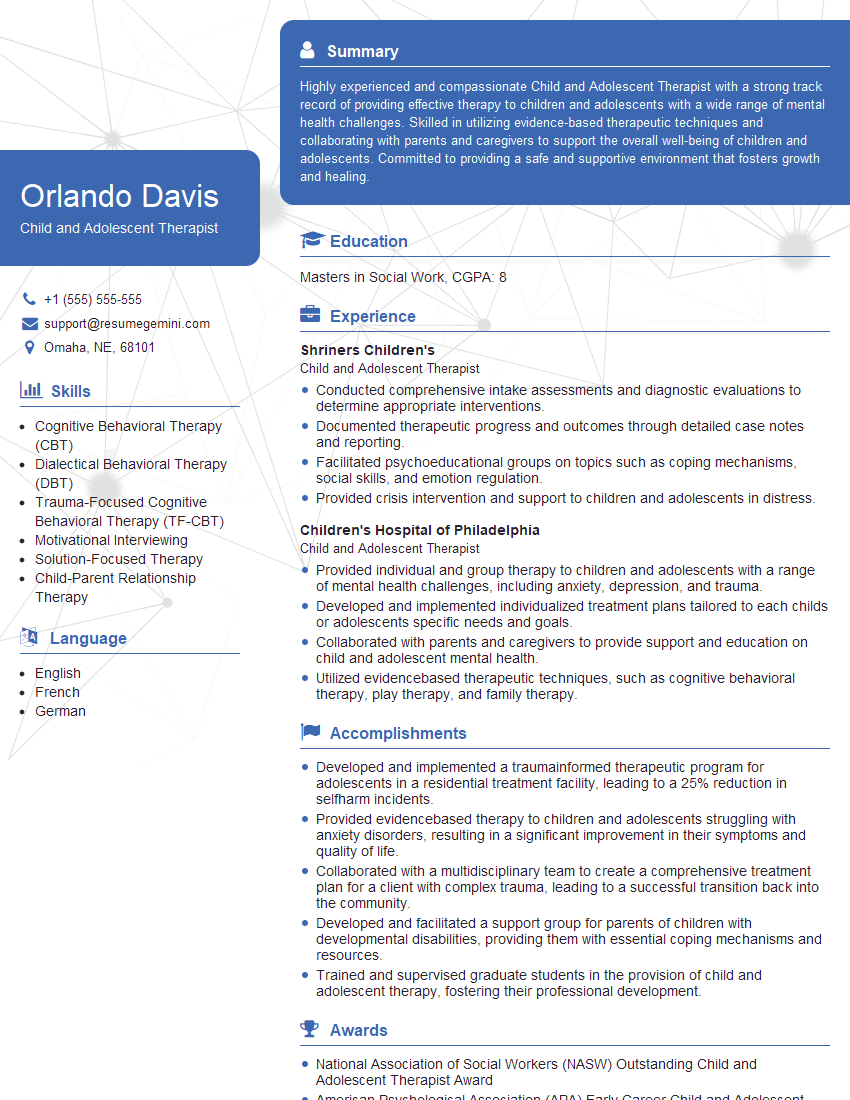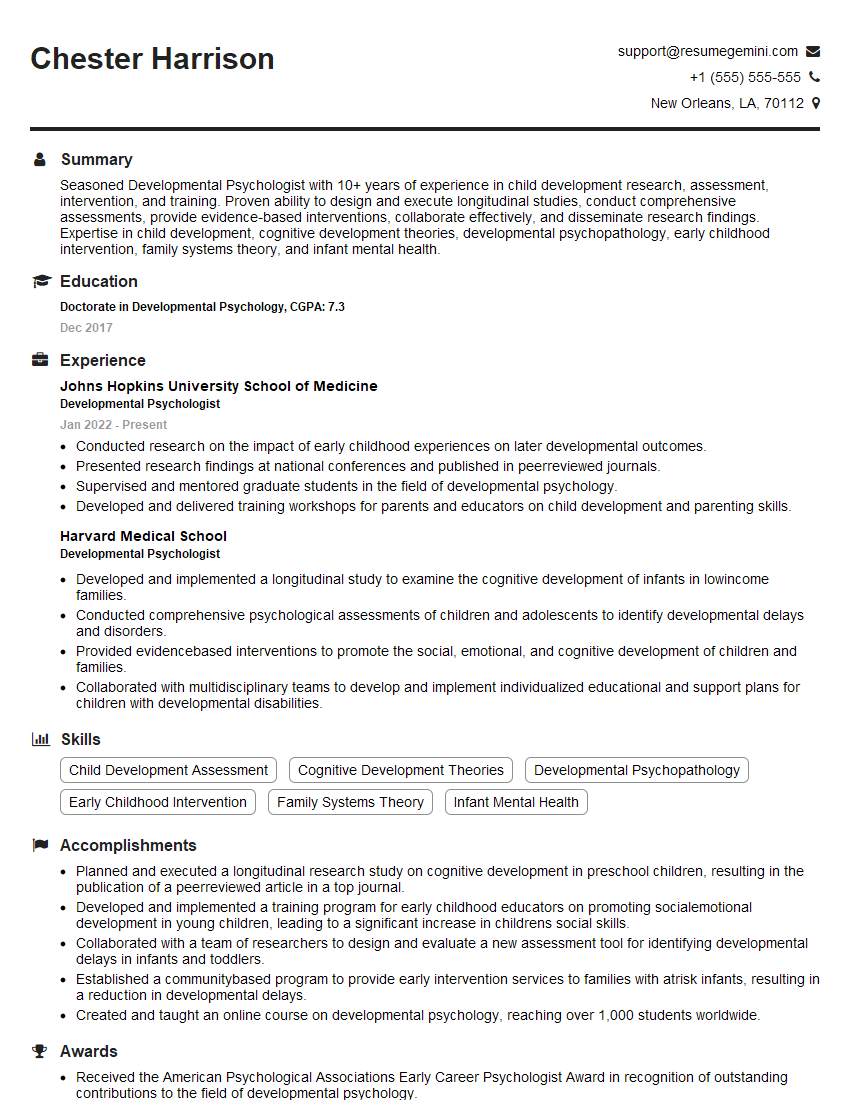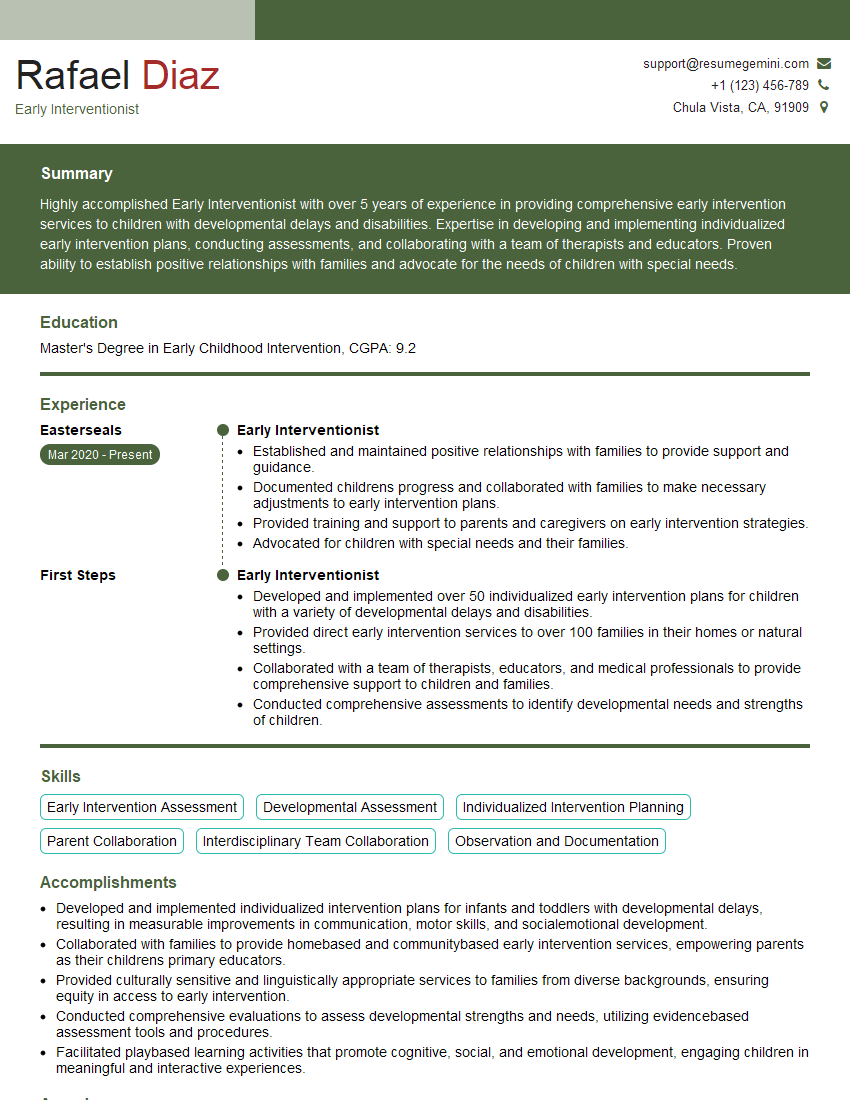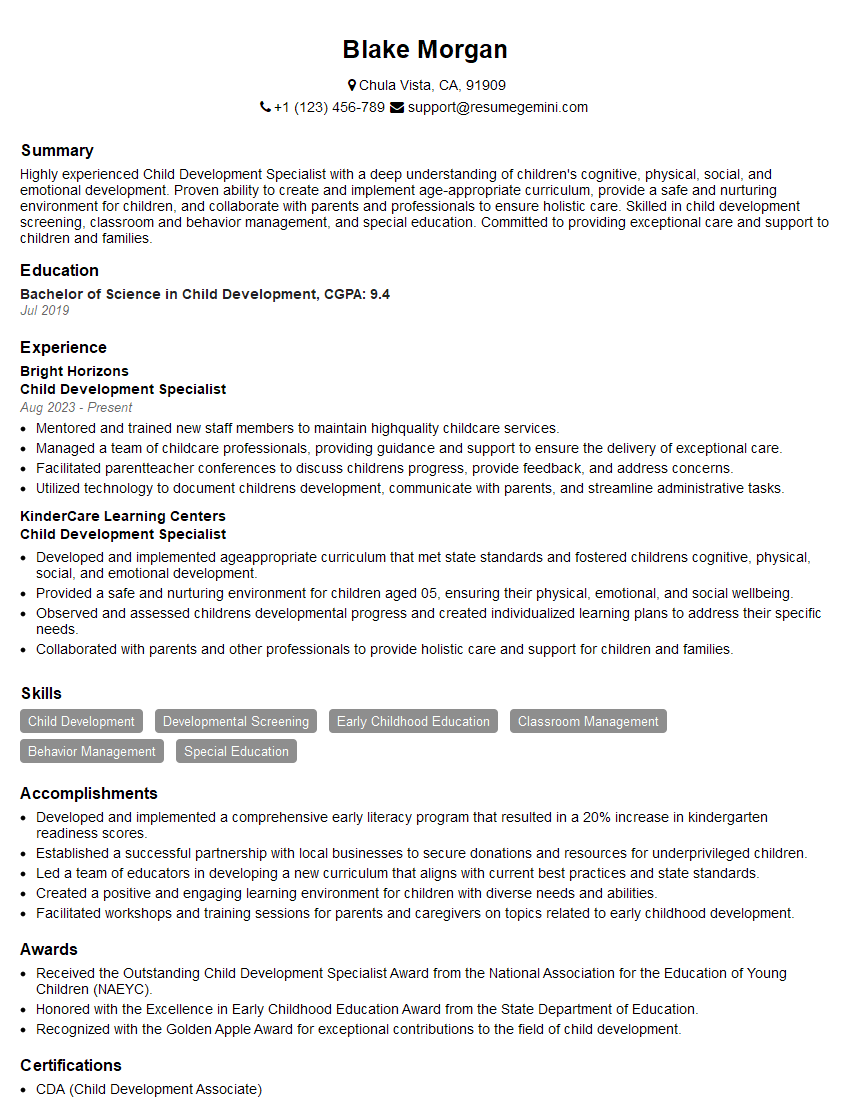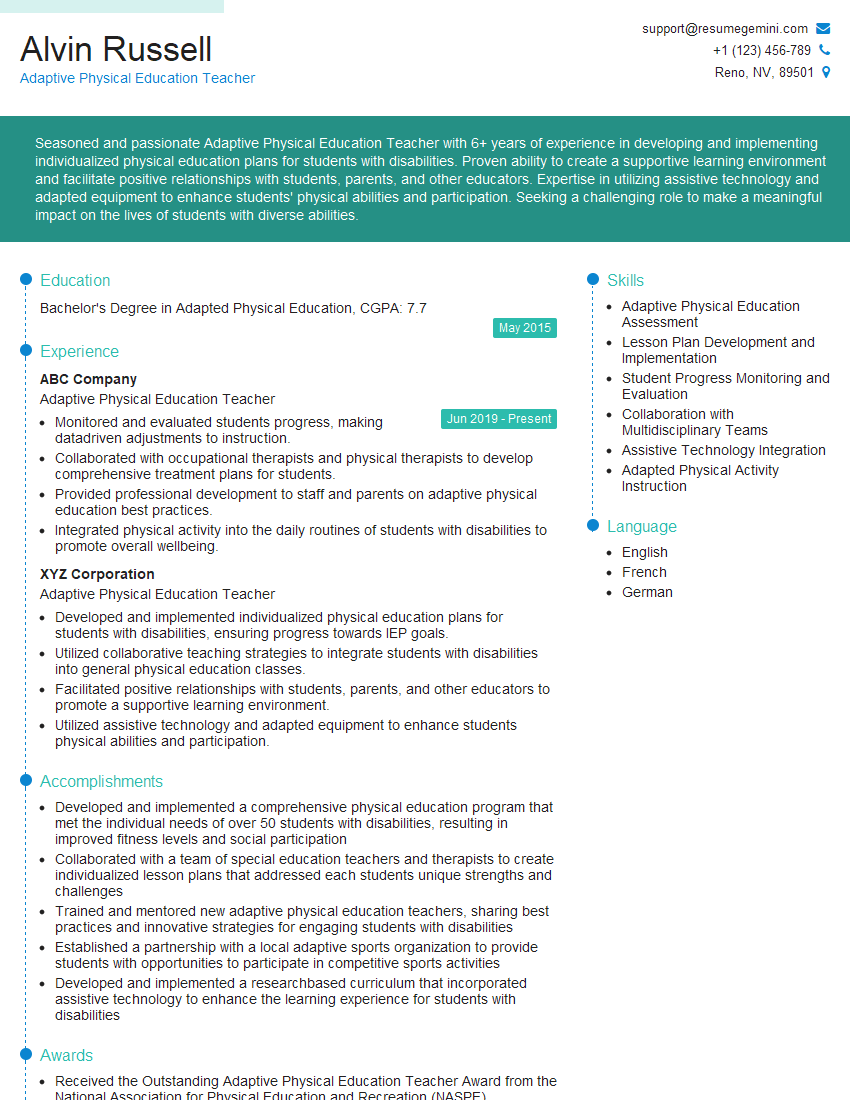Feeling uncertain about what to expect in your upcoming interview? We’ve got you covered! This blog highlights the most important Child Development Assessment interview questions and provides actionable advice to help you stand out as the ideal candidate. Let’s pave the way for your success.
Questions Asked in Child Development Assessment Interview
Q 1. Describe the key developmental milestones in the first three years of life.
The first three years of life are a period of explosive growth and development. Milestones are typically categorized into physical, cognitive, social-emotional, and language domains, and they are not always achieved at the same rate by all children. A child’s development is best understood as a range, rather than a single point in time.
- Physical Development: From holding their head up and rolling over in the first few months, to crawling, pulling themselves up, and eventually walking (typically between 9 and 15 months), gross motor skills rapidly progress. Fine motor skills, such as grasping objects, using utensils, and eventually drawing, also significantly develop.
- Cognitive Development: Infants initially respond to stimuli reflexively. Over time, they develop object permanence (understanding that objects exist even when out of sight), begin to understand cause and effect, and show problem-solving skills, even at a very basic level.
- Social-Emotional Development: Early social-emotional development focuses on attachment to caregivers. Infants develop a sense of trust and security, learning to express emotions through vocalizations and facial expressions. As they grow, they show increasing awareness of others and their feelings, beginning to develop empathy and social interactions.
- Language Development: Language development progresses from cooing and babbling to understanding simple words and eventually producing words and simple sentences. By three, most children can speak in short phrases and understand simple instructions.
It’s important to remember that there’s a wide range of normal development. While these are typical milestones, some children may reach them earlier or later without cause for concern. Early intervention is key if a child shows significant delays.
Q 2. Explain the difference between normative and criterion-referenced assessment.
Normative and criterion-referenced assessments serve different purposes in evaluating a child’s development.
- Normative assessments compare a child’s performance to that of a larger group of children of the same age. Scores are typically presented as percentiles or standard scores, indicating the child’s relative standing within the normative sample. For example, a score at the 50th percentile means the child performed as well as or better than 50% of the children in the normative sample. The standardized tests like the Bayley Scales of Infant and Toddler Development are examples of normative assessments.
- Criterion-referenced assessments evaluate a child’s performance against a specific set of criteria or skills. They don’t compare the child to others; instead, they determine what the child can and cannot do. A developmental checklist assessing whether a child can dress themselves, tie their shoes, or identify colors is an example of a criterion-referenced assessment.
In practice, both types of assessment offer valuable information. Normative assessments provide a broad picture of a child’s developmental level compared to peers, highlighting potential areas of concern. Criterion-referenced assessments pinpoint specific skills that a child may or may not have mastered, enabling the design of targeted interventions.
Q 3. What are the common methods used in assessing cognitive development in children?
Assessing cognitive development in young children requires a multifaceted approach, employing various methods to gain a comprehensive understanding.
- Standardized intelligence tests: Tests like the Bayley Scales, Stanford-Binet Intelligence Scales, or Wechsler Preschool and Primary Scale of Intelligence (WPPSI) measure cognitive abilities such as problem-solving, reasoning, and memory. These provide a quantifiable measure of cognitive functioning but should be interpreted cautiously, considering the limitations of standardized testing with young children.
- Developmental scales and checklists: These tools assess a range of developmental skills, including cognitive abilities, and provide a broader picture of a child’s overall development. Examples include the Ages and Stages Questionnaires (ASQ).
- Observations: Observing a child’s play, interaction with others, and problem-solving strategies in natural settings offers valuable insights into their cognitive abilities. This is particularly useful for assessing creativity, flexibility, and social cognition.
- Parent/Caregiver Reports: Gathering information from parents or caregivers who spend the most time with the child helps build a holistic understanding of their cognitive abilities, including aspects like attention and memory. They can provide valuable context that standardized tests might miss.
A combination of these methods provides a more nuanced understanding of a child’s cognitive development than relying on a single assessment.
Q 4. How do you assess social-emotional development in preschool-aged children?
Assessing social-emotional development in preschoolers requires a holistic approach, combining multiple assessment methods.
- Observations: Observing children in various settings – free play, group activities, and interactions with peers and adults – provides crucial information about their social skills, emotional regulation, and self-control. Looking for behaviors like sharing, cooperation, conflict resolution, and emotional expression is important.
- Parent/Teacher Reports: Questionnaires and interviews with parents and teachers provide valuable insights into a child’s behavior at home and school. They can offer information on areas such as self-esteem, social interaction, emotional regulation, and empathy that may not be readily apparent during a short observation.
- Play-based assessments: Using play as a means of assessment can reveal a child’s social-emotional understanding. The way a child interacts with toys, engages in pretend play, and interacts with a therapist during play can uncover a lot about their emotional regulation, empathy, and understanding of social interactions.
- Standardized social-emotional assessments: Some standardized tools, though less common than cognitive tests, specifically assess aspects of social-emotional functioning. These should be used as part of a larger assessment.
Interpreting the data from these sources requires a careful consideration of the context. A child might exhibit challenging behaviors in one setting but not another, highlighting the need for a holistic view of their development. Any significant concern should lead to further investigation and potentially intervention.
Q 5. What are some common signs of developmental delays in language acquisition?
Developmental delays in language acquisition can manifest in several ways, and early identification is crucial for intervention.
- Limited vocabulary: A significantly smaller vocabulary than expected for the child’s age is a strong indicator. For instance, a three-year-old with a vocabulary of only a few words should raise concern.
- Difficulty understanding language: Children may struggle to follow simple instructions or understand basic questions. They might consistently miss the point of conversations.
- Problems with speech production: This includes difficulty forming sounds, using incorrect grammatical structures, or having trouble saying words clearly. Stuttering or lisping, beyond typical developmental variations, could be an indicator.
- Lack of spontaneous communication: Children might not initiate conversations or communicate their needs effectively, even though they might understand what is being said to them.
- Repetitive or unusual language patterns: Unusual speech patterns, such as echolalia (repeating others’ words) or limited use of language for functional purposes, should be noticed.
The severity and combination of these signs vary greatly. If you suspect a language delay, consulting with a speech-language pathologist is crucial for accurate diagnosis and appropriate intervention.
Q 6. Describe your experience using standardized developmental assessments.
Throughout my career, I’ve extensively used standardized developmental assessments such as the Bayley Scales, the Denver Developmental Screening Test, and the ASQ. My experience includes administering these assessments to children across diverse backgrounds and developmental levels. I’m proficient in following standardized administration procedures, scoring protocols, and interpreting the results.
For example, I recall a case where a child was referred to me due to concerns about developmental delays. Using the Bayley Scales, I identified significant delays in his gross motor skills and cognitive development. This standardized assessment provided objective data, highlighting specific areas requiring intervention. This, combined with observations and parental reports, allowed me to develop a tailored intervention plan involving physiotherapy and early childhood education.
I am always mindful of the limitations of standardized tests; They are just one piece of the puzzle. I always supplement these with other assessment methods to get a comprehensive understanding.
Q 7. How do you interpret standardized test scores and integrate them with other data sources?
Interpreting standardized test scores requires careful consideration of several factors beyond just the raw score. It’s crucial to understand the specific test’s standardization sample, the child’s age, and the context of the assessment. Scores are usually converted into standard scores or percentiles, making it possible to compare a child’s performance to their peers.
Integrating standardized test scores with other data sources is essential for a comprehensive understanding. I use a holistic approach, combining test results with:
- Observations of the child’s behavior and interactions: This allows me to contextualize the test scores and identify behaviors that might not be captured by the test itself.
- Parent and teacher reports: These reports provide valuable insights into the child’s daily functioning and developmental trajectory, offering a more detailed picture than any single test.
- Medical history: Any medical conditions or factors that might influence the child’s performance need to be considered.
For instance, a child might score below average on a cognitive test but show exceptional creativity and problem-solving skills in play-based activities. This discrepancy calls for further investigation to determine if the test score accurately reflects the child’s capabilities. The holistic approach ensures a comprehensive and nuanced understanding of the child’s development, guiding effective interventions.
Q 8. Explain the role of play in child development assessment.
Play is not just fun; it’s a crucial window into a child’s cognitive, social-emotional, and physical development. In assessment, we use play-based methods because they allow children to express themselves naturally and authentically, providing a more valid and reliable picture than traditional, structured tests, especially with younger children.
For instance, observing a child’s play with building blocks can reveal their problem-solving skills, spatial reasoning, and fine motor dexterity. Their interaction with peers during free play offers insights into their social skills, cooperation, and conflict resolution abilities. Symbolic play, such as pretend play, shows their understanding of the world, their imagination, and their language development. We use standardized play-based assessments like the Bayley Scales of Infant and Toddler Development or the Play Assessment Scale for Toddlers and Preschoolers, but also observe spontaneous play to gain a holistic understanding.
We look for things like the child’s level of engagement, the complexity of their play, the types of themes they explore, and how they interact with play materials and other children. This information is then integrated into a comprehensive developmental profile.
Q 9. How do you adapt assessment methods for children with diverse cultural backgrounds?
Adapting assessment methods for children from diverse cultural backgrounds is paramount to ensure fair and accurate evaluation. Cultural biases can significantly influence test performance. We address this through several strategies.
- Culturally sensitive assessment materials: We use assessment tools that are relevant to the child’s cultural experiences and avoid those that contain culturally specific references or biases. For example, using storybooks familiar to the child’s culture instead of generic ones.
- Use of interpreters and bilingual assessors: When there is a language barrier, we use qualified interpreters or assessors fluent in the child’s language. This ensures accurate communication and avoids misinterpretations.
- Understanding cultural norms: We educate ourselves on the child’s cultural norms and practices relating to eye contact, physical touch, and communication styles. For instance, a child from a culture where direct eye contact is considered disrespectful might be wrongly interpreted as being shy or unengaged.
- Observation in natural settings: Instead of solely relying on standardized tests, we observe the child in familiar environments, such as their home or daycare, which allows for a more natural and less biased assessment of their abilities.
- Collaboration with the family: We actively involve the family in the assessment process, valuing their insights and perspectives on the child’s development. Their understanding of the child’s strengths and challenges within their cultural context is crucial.
Q 10. Describe your experience working with children with disabilities.
I have extensive experience working with children with diverse disabilities, including developmental delays, autism spectrum disorder, cerebral palsy, and learning disabilities. My approach is always individualized and person-centered, focusing on the child’s unique strengths and needs.
For example, I worked with a young boy diagnosed with autism who had significant communication challenges. Instead of relying solely on verbal communication assessments, we used a combination of observations, play-based interactions, and assistive technology to understand his communication abilities and preferences. By observing his play with various toys, we discovered a strong preference for visual aids and symbolic play, which helped tailor an effective communication intervention.
Another example involved collaborating with a team to assess a child with cerebral palsy. We used adaptive assessment tools and methods, considering her physical limitations. This included modifications in test administration, such as using alternative response methods (e.g., pointing, eye gaze) and adjusting the testing environment to accommodate her physical needs. The assessment revealed her strengths in problem-solving and cognitive abilities, despite her physical challenges. This informed an intervention plan focusing on assistive technology and adapted learning strategies.
Q 11. How do you communicate assessment results to parents and caregivers?
Communicating assessment results effectively to parents and caregivers is crucial for building trust and fostering collaboration. I believe in a collaborative approach to sharing information.
I start by scheduling a meeting in a comfortable and private setting. I present the findings in clear, non-technical language, avoiding jargon. I use visuals like charts and graphs to illustrate the results and make them easier to understand.
I always focus on the child’s strengths and positive attributes, highlighting their abilities and potentials. I explain the implications of the findings and answer any questions that the parents may have in a sensitive and empathetic manner. I then collaboratively discuss options for intervention or support, ensuring the parents actively participate in the decision-making process. I provide written summaries of the results, including recommendations, and resources for further support.
I follow-up with parents to address any ongoing concerns and monitor the effectiveness of the intervention plan. A crucial aspect is ensuring the parents understand they are partners in the process and empowered to support their child’s development.
Q 12. How do you develop an appropriate intervention plan based on assessment findings?
Developing an appropriate intervention plan is a collaborative process guided by assessment findings, parental input, and evidence-based practices. It begins with identifying the child’s developmental strengths and needs, and then setting realistic and achievable goals.
For example, if an assessment reveals a language delay, the intervention plan might involve speech therapy, targeted language activities at home, and strategies for enhancing communication in the classroom. Each goal is broken down into smaller, manageable steps. The plan should outline specific, measurable, achievable, relevant, and time-bound (SMART) goals. We regularly monitor progress, making adjustments to the plan as needed.
I use a variety of intervention strategies, including play-based therapy, behavioral interventions, and educational strategies, tailored to the child’s individual needs and learning style. The plan also involves recommendations for the family and caregivers on how to support the child’s development at home and in other settings. Collaboration with educators, therapists, and other professionals is crucial to ensure a cohesive and comprehensive intervention approach.
Q 13. What are the ethical considerations in conducting child development assessments?
Ethical considerations are central to child development assessment. We must prioritize the child’s well-being, rights, and dignity throughout the entire process.
- Informed consent: We obtain informed consent from parents or legal guardians before conducting any assessments. This involves explaining the purpose, procedures, potential benefits, and risks associated with the assessment.
- Child’s participation and comfort: We involve the child in the assessment process as appropriate for their age and developmental level. We ensure the assessment is conducted in a safe, comfortable, and non-threatening environment. We respect the child’s cues and stop the assessment if they become distressed.
- Competence: We only use assessment methods and interpretations we are qualified and trained to use. We adhere to professional standards and guidelines.
- Confidentiality and privacy: We protect the child’s confidential information and comply with relevant data protection laws.
- Cultural sensitivity: We are mindful of cultural differences and avoid cultural biases in assessment procedures and interpretation.
- Beneficence and non-maleficence: We act in the best interests of the child, minimizing any potential harm and maximizing potential benefits.
- Justice and fairness: We ensure that all children have equal access to appropriate developmental assessments regardless of their background or circumstances.
Q 14. How do you maintain confidentiality and privacy of child assessment data?
Maintaining confidentiality and privacy of child assessment data is paramount. We adhere to strict protocols to ensure that sensitive information is protected.
- Secure storage of data: Assessment records are kept in secure, locked cabinets or electronic databases with access restricted to authorized personnel only.
- Data encryption: When electronic records are used, we employ strong encryption methods to protect against unauthorized access.
- Anonymization and de-identification: When sharing data for research or other purposes, we anonymize or de-identify it to protect the child’s identity.
- Compliance with regulations: We strictly adhere to all relevant data protection laws, such as HIPAA (in the US) or GDPR (in Europe).
- Informed consent for data sharing: We obtain informed consent from parents or guardians before sharing any information with other professionals or agencies.
- Limited access policy: Only individuals directly involved in the child’s care have access to the assessment data.
We educate parents about the importance of data privacy and provide them with clear information on how their child’s data is handled and protected.
Q 15. Describe your familiarity with different theoretical frameworks in child development (e.g., Piaget, Vygotsky, Erikson).
My understanding of child development is deeply rooted in several key theoretical frameworks. These frameworks offer different lenses through which to view a child’s growth and development, and I utilize them in a complementary, not mutually exclusive, manner.
- Piaget’s theory of cognitive development emphasizes the stages of cognitive growth, from sensorimotor to formal operational. I use this to understand a child’s capacity for logical reasoning, problem-solving, and abstract thought at different ages. For instance, understanding that a child is in the preoperational stage helps me interpret their egocentric thinking and avoid expecting adult-like reasoning abilities.
- Vygotsky’s sociocultural theory highlights the role of social interaction and scaffolding in learning. This informs my assessment by considering the child’s cultural background and their interactions with others. I assess the child’s Zone of Proximal Development (ZPD), identifying tasks they can accomplish with support but not independently. This helps tailor interventions to maximize learning potential.
- Erikson’s psychosocial theory focuses on the development of personality throughout the lifespan. I use this to understand the child’s emotional and social development, considering their progress through different psychosocial stages and potential challenges. For example, a child struggling with the autonomy versus shame and doubt stage might exhibit defiance, which needs to be understood within this developmental context.
Integrating these frameworks helps me create a comprehensive and holistic understanding of the child’s development, allowing for more targeted and effective assessments and interventions.
Career Expert Tips:
- Ace those interviews! Prepare effectively by reviewing the Top 50 Most Common Interview Questions on ResumeGemini.
- Navigate your job search with confidence! Explore a wide range of Career Tips on ResumeGemini. Learn about common challenges and recommendations to overcome them.
- Craft the perfect resume! Master the Art of Resume Writing with ResumeGemini’s guide. Showcase your unique qualifications and achievements effectively.
- Don’t miss out on holiday savings! Build your dream resume with ResumeGemini’s ATS optimized templates.
Q 16. Explain the importance of observation in child development assessment.
Observation is fundamental to child development assessment. It provides rich, qualitative data that standardized tests often miss. Direct observation allows me to see a child’s behavior in natural settings, revealing nuances that questionnaires or interviews might not capture.
For example, I might observe a child’s play interactions to assess social skills, their problem-solving approach during a task, or their emotional regulation in response to frustration. I carefully document the context of the observation, noting the setting, the child’s behavior, and any interactions with others. This naturalistic approach offers invaluable insights into the child’s developmental strengths and challenges.
Structured observation, utilizing checklists or rating scales, enhances objectivity and allows for comparison across different children. This structured approach can be combined with naturalistic observation to get a well-rounded picture.
Q 17. What are the key differences between formative and summative assessments?
Formative and summative assessments serve distinct purposes in child development. Think of them as ongoing feedback versus a final grade.
- Formative assessments are ongoing evaluations throughout a learning process. They focus on monitoring progress, identifying areas for improvement, and providing timely feedback to guide instruction. Examples include regular classroom observations, informal assessments during play, or frequent check-ins with parents. They are designed to improve the child’s development along the way.
- Summative assessments occur at the end of a defined period to summarize learning. These assessments often involve standardized tests or comprehensive evaluations to gauge overall achievement or developmental status. Examples include annual developmental screenings or final evaluations at the end of a therapeutic intervention. They provide a snapshot of the child’s overall progress.
While summative assessments provide a summary of development, formative assessments are crucial for adapting interventions and maximizing learning. They are both necessary for effective child development practice.
Q 18. How do you identify and address potential biases in assessment procedures?
Addressing potential biases in assessment procedures is crucial for ensuring fairness and accuracy. Biases can stem from various sources, including the assessor’s cultural background, personal beliefs, and even the assessment tools themselves.
To mitigate bias:
- Cultural Sensitivity: I use culturally appropriate assessment materials and adapt my approach to respect the child’s cultural background and language. I also ensure that the assessment environment is comfortable and familiar for the child.
- Objective Scoring: I adhere strictly to standardized procedures for administering and scoring assessments, minimizing subjective interpretation. Using clear and well-defined criteria helps prevent individual biases from influencing the results.
- Multiple Assessment Methods: I employ multiple assessment methods—observations, interviews, standardized tests—to gain a holistic view. This reduces reliance on any single measure, which may be subject to bias.
- Self-Reflection: Regular self-reflection helps me identify my own biases and limitations. Seeking supervision from colleagues helps further reduce personal bias and refine professional judgment.
By proactively addressing potential biases, I strive to ensure that assessment results accurately reflect the child’s abilities and needs.
Q 19. What is your experience with specific developmental assessments (e.g., Bayley Scales, Stanford-Binet, Woodcock-Johnson)?
My experience encompasses a range of widely used developmental assessments. I’m proficient in administering and interpreting results from several tests, adapting my approach based on the child’s age and specific needs.
- Bayley Scales of Infant and Toddler Development: I use this to assess infants and toddlers’ cognitive, language, motor, and socio-emotional development. The detailed subtests provide a comprehensive picture of early development.
- Stanford-Binet Intelligence Scales: This is a widely recognized test for assessing intellectual abilities across a broad age range. I use it to evaluate cognitive strengths and weaknesses, keeping in mind the limitations of IQ scores in fully capturing a child’s potential.
- Woodcock-Johnson Tests of Achievement: This comprehensive battery assesses academic skills in areas like reading, math, and written language. I use it to identify learning disabilities and inform educational interventions.
It’s crucial to remember that no single assessment provides a complete picture of a child. I always consider multiple sources of information and avoid over-reliance on any single test score. The clinical interpretation of these assessments requires a nuanced understanding of both test strengths and limitations, alongside observation and contextual information.
Q 20. Explain your understanding of different types of developmental disabilities (e.g., Autism, Down Syndrome, Cerebral Palsy).
Understanding different developmental disabilities is essential for providing appropriate assessment and intervention. These conditions vary significantly in their presentation and impact.
- Autism Spectrum Disorder (ASD): Characterized by challenges with social interaction, communication, and repetitive behaviors. Assessment focuses on identifying these core features through observation, parent interviews, and standardized assessments, such as the Autism Diagnostic Observation Schedule (ADOS).
- Down Syndrome: A genetic condition resulting in intellectual disability and characteristic physical features. Assessment includes evaluating cognitive abilities, adaptive skills, and physical development, considering the variability among individuals with Down syndrome.
- Cerebral Palsy: A group of disorders affecting movement and posture due to brain damage. Assessment focuses on motor skills, muscle tone, and range of motion, often involving physical therapy evaluations and specialized assessments.
Each disability necessitates a tailored assessment approach to accurately identify strengths and challenges, allowing for the development of individualized support plans. It’s vital to remember the heterogeneity within these diagnostic categories, meaning significant individual differences exist within each.
Q 21. How do you assess adaptive behavior in children?
Assessing adaptive behavior is crucial because it measures a child’s ability to function independently in daily life. It’s distinct from cognitive abilities and provides a more holistic view of a child’s overall functioning.
Assessment methods include:
- Parent/Teacher Reports: Questionnaires and rating scales provide valuable information about the child’s daily living skills, such as dressing, eating, and personal hygiene. The Vineland Adaptive Behavior Scales is a commonly used instrument.
- Direct Observation: Observing the child in natural settings helps assess their ability to perform tasks independently. For example, I might observe the child’s ability to follow instructions, participate in social activities, or manage their personal belongings.
- Functional Behavioral Assessment (FBA): This is especially helpful for children with behavioral challenges. It involves identifying the antecedents and consequences of problematic behaviors to understand their function and develop effective interventions.
Assessing adaptive behavior helps identify areas where a child may need support to achieve greater independence and participation in their daily routines.
Q 22. How do you differentiate between developmental delays and learning disabilities?
Developmental delays and learning disabilities, while both impacting a child’s development, differ significantly in their underlying causes and manifestations. A developmental delay refers to a lag in acquiring age-appropriate skills across various developmental domains (physical, cognitive, social-emotional, communication). This delay can be temporary and often resolves with intervention. Think of it like a child being slower to reach a milestone, but with appropriate support, they can eventually catch up. For instance, a child who starts walking later than their peers but then exhibits typical walking skills later on would be considered to have experienced a developmental delay.
A learning disability, on the other hand, is a neurological condition that affects a child’s ability to learn and process information in specific areas, despite having average or above-average intelligence. These difficulties persist over time and aren’t simply a matter of slower development; they represent a different way the brain processes information. Dyslexia (reading difficulties), dysgraphia (writing difficulties), and dyscalculia (math difficulties) are common examples. A child with dyslexia might struggle to decode words even with extensive tutoring, even though they possess normal cognitive abilities in other areas.
The key differentiator lies in the persistence and nature of the difficulty. Developmental delays often improve with intervention, while learning disabilities require specialized instruction and support to address the specific cognitive processing challenges.
Q 23. Describe your experience using informal assessment methods.
Informal assessment methods are crucial for gaining a holistic understanding of a child’s development, especially in the initial stages of assessment. My experience includes using a variety of techniques, including observation in natural settings (e.g., observing play interactions, classroom participation), checklists (e.g., documenting developmental milestones reached), anecdotal records (brief descriptions of significant behaviors or events), and play-based assessments (e.g., observing a child’s play to assess creativity, problem-solving, and social skills).
For example, I recently assessed a preschooler using a combination of methods. Observing him during free play revealed excellent fine motor skills but challenges with social interaction. A checklist indicated he met milestones in language development but lagged slightly in gross motor skills. Combining this information with anecdotal records from teachers and parents provided a complete picture of his strengths and weaknesses, enabling me to develop a targeted intervention plan.
Informal assessments allow for flexibility and adaptability, particularly valuable with younger children or those with diverse needs. They help build rapport and make the assessment process less stressful, generating more natural and revealing behaviors.
Q 24. How do you involve families in the assessment process?
Family involvement is paramount in the assessment process; it’s not just about the child; it’s about the entire family system. I actively involve families from the outset, starting with clear communication about the purpose and process of the assessment. This involves explaining assessment procedures in a language they understand, answering their questions thoroughly, and respecting their concerns. I encourage parents and caregivers to share their observations and insights, creating a collaborative partnership.
I use a variety of methods to facilitate family participation, including interviews, questionnaires, and home visits (with consent). For example, I’ll ask parents to maintain a daily diary of their child’s behavior, helping provide context and data beyond what I can observe in a clinical setting. Regular feedback sessions are crucial to ensure families feel heard and informed throughout the process. Their perspective provides a critical piece of the puzzle, offering crucial context to the child’s development and experiences.
By empowering families, we improve the accuracy of the assessment and ensure the recommendations are practical and culturally sensitive, increasing the likelihood of successful intervention.
Q 25. What strategies do you use to build rapport with children during assessments?
Building rapport with children, especially during assessments, is crucial for accurate and reliable results. My approach focuses on creating a safe, comfortable, and playful environment. I begin by introducing myself and explaining the assessment in simple, age-appropriate terms, using visuals or play materials to illustrate the process.
I carefully observe the child’s cues and adapt my approach based on their temperament and preferences. Some children respond well to structured activities, while others prefer more spontaneous play. I always allow for breaks and flexibility, understanding that children need time to adjust and feel comfortable. Positive reinforcement, such as verbal praise, smiles, and encouragement, helps build confidence and motivation. I might start with a fun activity that allows me to subtly assess their skills, such as playing a simple game or drawing pictures, leading to a more natural transition into more formal assessment measures. I always remember that each child is unique and requires a tailored approach.
Ultimately, a strong rapport fosters trust and cooperation, allowing me to gather more accurate information about the child’s developmental abilities.
Q 26. How do you manage challenging behaviors during an assessment?
Managing challenging behaviors during an assessment requires patience, flexibility, and a proactive approach. It’s important to understand the potential underlying causes of the behavior, which might include anxiety, frustration, or sensory overload. I use strategies grounded in positive behavior support, focusing on preventing challenging behaviors rather than simply reacting to them. This might involve structuring the assessment to minimize triggers (e.g., providing frequent breaks, changing activities), and using clear communication and expectations.
If challenging behaviors do arise, I implement de-escalation techniques, such as remaining calm, using a quiet and reassuring tone of voice, and offering choices to the child to regain a sense of control. I carefully document the behavior, noting the context, triggers, and the child’s responses to interventions. Collaborating with parents or caregivers is key to understanding the child’s behavior patterns in various contexts and adapting my approach accordingly. In some cases, further consultation with other professionals might be necessary to address underlying issues contributing to the challenging behavior.
It’s vital to remember that challenging behavior is often a communication of unmet needs, and addressing those needs is central to managing it effectively.
Q 27. How do you ensure the assessment process is culturally sensitive and appropriate?
Cultural sensitivity is essential for conducting fair and unbiased assessments. I ensure cultural appropriateness by considering several factors. Firstly, I avoid using assessment materials that rely heavily on cultural-specific knowledge or experiences. Secondly, I’m mindful of language barriers and use interpreters or translated materials when necessary. Thirdly, I consider the family’s beliefs, values, and practices, adjusting my approach to align with their cultural norms. I also ensure to understand and respect cultural variations in communication styles and expressions. For example, eye contact can be interpreted differently across cultures.
I’m actively working to increase my understanding of various cultures and cultural biases and I collaborate with community members and cultural experts to learn about diverse cultural perspectives. I make sure the communication style I employ is easy to understand and doesn’t cause undue stress or discomfort to the family or the child. If necessary I select alternative assessment tools or methods that are more culturally appropriate. A culturally sensitive assessment ensures that the results accurately reflect the child’s abilities, rather than their cultural background.
By embracing cultural humility and actively seeking to understand the unique perspectives of each family, we can ensure that every child receives a just and equitable assessment.
Key Topics to Learn for Child Development Assessment Interview
- Developmental Milestones: Understanding typical developmental milestones across various domains (cognitive, physical, social-emotional, language) for different age groups. Be prepared to discuss variations within the normal range and potential red flags indicating developmental delays.
- Assessment Methods: Familiarize yourself with various assessment tools and techniques used in child development assessment, including standardized tests, observation methods, and informal assessments. Consider the strengths and limitations of each approach.
- Theoretical Frameworks: Demonstrate your understanding of key theoretical perspectives on child development (e.g., Piaget, Vygotsky, Erikson, etc.) and how these theories inform assessment practices. Be ready to discuss how different theories influence your approach to assessment and intervention.
- Ethical Considerations: Understand the ethical implications of child development assessment, including confidentiality, informed consent, cultural sensitivity, and appropriate use of assessment data.
- Interpreting Assessment Results: Practice analyzing assessment data to identify developmental strengths and weaknesses. Be prepared to discuss how you would communicate assessment findings to parents, caregivers, and other professionals in a clear and understandable way.
- Intervention Strategies: Discuss your understanding of evidence-based intervention strategies for addressing developmental delays or challenges. This shows you can connect assessment to practical application and positive outcomes.
- Case Study Analysis: Practice analyzing hypothetical case studies involving children with diverse developmental needs. This will help you demonstrate your problem-solving skills in real-world scenarios.
Next Steps
Mastering Child Development Assessment is crucial for career advancement in this field, opening doors to rewarding roles with greater responsibility and impact. A strong, ATS-friendly resume is your key to unlocking these opportunities. To significantly enhance your job prospects, we encourage you to leverage ResumeGemini, a trusted resource for creating professional and effective resumes. ResumeGemini offers examples of resumes specifically tailored to Child Development Assessment professionals, providing you with a valuable template and inspiration to showcase your unique skills and experience.
Explore more articles
Users Rating of Our Blogs
Share Your Experience
We value your feedback! Please rate our content and share your thoughts (optional).
What Readers Say About Our Blog
This was kind of a unique content I found around the specialized skills. Very helpful questions and good detailed answers.
Very Helpful blog, thank you Interviewgemini team.
